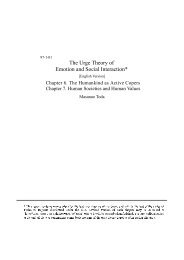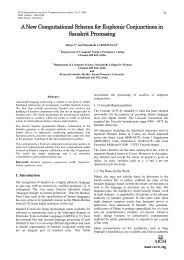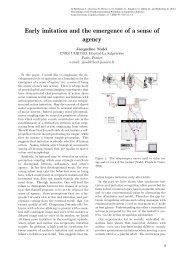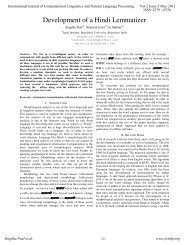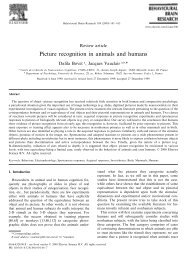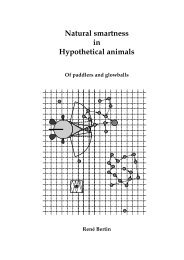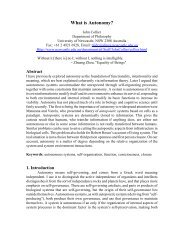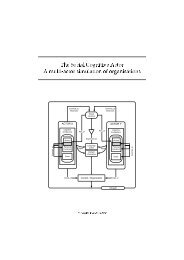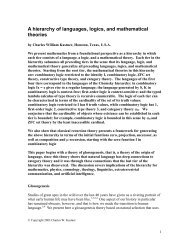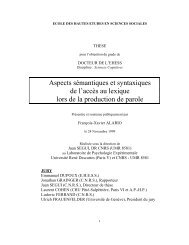Case Report: Primary Amoebic (Naegleria fowleri ... - Cogprints
Case Report: Primary Amoebic (Naegleria fowleri ... - Cogprints
Case Report: Primary Amoebic (Naegleria fowleri ... - Cogprints
Create successful ePaper yourself
Turn your PDF publications into a flip-book with our unique Google optimized e-Paper software.
Online Journal of Health and Allied Sciences<br />
Peer Reviewed, Open Access, Free Online Journal<br />
Published Quarterly : Mangalore, South India : ISSN 0972-5997<br />
Volume 10, Issue 1; Jan-Mar 2011<br />
This work is licensed under a<br />
Creative Commons Attribution-<br />
No Derivative Works 2.5 India License<br />
<strong>Case</strong> <strong>Report</strong>:<br />
<strong>Primary</strong> <strong>Amoebic</strong> (<strong>Naegleria</strong> <strong>fowleri</strong>) Meningoencephalitis Presenting as Status Epilepticus<br />
A Sharma, Professor,<br />
R Raina, Associate professor,<br />
P Jaret, Assistant professor,<br />
V Bharti, Senior resident,<br />
G Gargi, Junior resident,<br />
P Panda, Junior resident,<br />
Dept. of Medicine, Indira Gandhi Medical College, Shimla, INDIA.<br />
Address for Correspondence:<br />
Dr. Prashant Panda,<br />
Junior Resident,<br />
Department of Medicine,<br />
Indira Gandhi Medical College,<br />
Shimla, INDIA.<br />
E-mail: prashantpanda85@gmail.com<br />
Citation: Sharma A, Raina R, Jaret P, Bharti V, Gargi G, Panda P. <strong>Primary</strong> <strong>Amoebic</strong> (<strong>Naegleria</strong> <strong>fowleri</strong>) Meningoencephalitis<br />
Presenting as Status Epilepticus. Online J Health Allied Scs. 2011;10(1):22<br />
URL: http://www.ojhas.org/issue37/2011-1-22.htm<br />
Open Access Archives: http://cogprints.org/view/subjects/OJHAS.html and http://openmed.nic.in/view/subjects/ojhas.html<br />
Submitted: Jan 22, 2011; Accepted: March 31, 2011; Published: April 15, 2011<br />
Abstract:<br />
<strong>Primary</strong> amebic meningoencephalitis (PAM) is a rare entity.<br />
Usual presenting features are fever, headache and seizures with<br />
meningeal signs and this disease carries high mortality rate. We<br />
present a case report of PAM presenting as status epilepticus.<br />
Key Words: <strong>Primary</strong> amebic meningoencephalitis; <strong>Naegleria</strong><br />
<strong>fowleri</strong>; Status epilepticus<br />
Introduction:<br />
N. <strong>fowleri</strong> is the only species of <strong>Naegleria</strong> genus that is pathogenic<br />
to humans. It is ubiquitous in natural fresh water lakes<br />
and ponds (especially warm water). It causes extremely rare<br />
and sporadic CNS infections. Typically, N. <strong>fowleri</strong> produces<br />
primary amebic meningoencephalitis (PAM), which is clinically<br />
indistinguishable from acute bacterial meningitis.<br />
<strong>Case</strong> <strong>Report</strong>:<br />
A 21 years female residing at district Bilaspur of Himachal Pradesh,<br />
presented with fever, headache and vomiting for 1 week<br />
and seizures for 1 day. Fever was high grade (up to 103°F), intermittent,<br />
associated with chills and rigors. Headache was diffuse<br />
dull aching to start with, present all over the head, and<br />
later on it increased in severity. She also had vomiting 7-8 episodes<br />
per day, mainly consisting of undigested food particles,<br />
non bilious, not containing any blood, mucus. There was also<br />
history of 7-8 episodes of generalised tonic clonic seizures<br />
without regaining consciousness. General physical examination<br />
was unremarkable. Neurological examination revealed unconscious<br />
state with neck rigidity and positive Kernig’s sign. The<br />
rest of the systemic examination was normal. Complete haemogram,<br />
LFT’s , RFT’s, and blood culture were normal. CSF examination<br />
revealed proteins 55 mg%, sugar 30 mg%, cytology<br />
7 WBCs, mostly lymphocytes. Wet mount specimen of CSF revealed<br />
motile flagellate forms of <strong>Naegleria</strong> <strong>fowleri</strong>. CSF was<br />
repeated twice which revealed similar form on microscopy.<br />
MRI brain was done which was normal. Retrospectively history<br />
revealed that she had taken a bath at a local pond. On the day 1,<br />
patient was initially started empirically on ceftriaxone, vancomycin,<br />
acyclovir and steroid on the lines of acute bacterial<br />
meningitis and acute viral encephalitis and also patient was<br />
dilantinised for status epilepticus. On day 2 after CSF report,<br />
patient was started on injection amphotericin. Despite this, patient<br />
deteriorated and she expired on 5 th day of admission.<br />
Discussion:<br />
<strong>Primary</strong> amebic meningoencephalitis is caused by free living<br />
amebas of genera <strong>Naegleria</strong> <strong>fowleri</strong>, Acanthamoeba and Balamuthia<br />
mandrillaris formerly known as leptomyxid amoeba.<br />
These are free living, amephizoic and opportunistic protozoa<br />
that are ubiquitous in nature. These amebas are found in soil,<br />
water, air samples from all over world. Man gets infected from<br />
inhalation of trophozoites or cysts on exposure to polluted water<br />
in ponds, swimming pools and manmade lakes. Nageleria<br />
<strong>fowleri</strong> is a thermophilic amoeba that grows well in tropical and<br />
subtropical climates and raised temperatures during hot summer<br />
months or warm water from power plants facilitates its growth.<br />
Human infection involves brain, lung, skin and eyes and has increased<br />
significantly since last 10 years. The portal of entry to<br />
CNS is through olfactory neuroepithelium. CNS infection occurs<br />
in two forms:<br />
a) <strong>Primary</strong> amebic meningoencephalitis, (PAME) caused by<br />
<strong>Naegleria</strong> <strong>fowleri</strong><br />
b) Granulomatous amebic encephalitis, (GAE) caused by species<br />
of Acanthamoeba and Balamuthia mandrillaris.<br />
Incubation period for N. <strong>fowleri</strong> is 3 to 7 days and that for<br />
acanthamoeba is unknown but perhaps more than 10 days.<br />
PAME produced by N. <strong>fowleri</strong> is characterized by acute fulminant<br />
meningoencephalitis with severe headache, high grade<br />
fever, nausea, vomiting, altered consciousness with signs of<br />
meningeal irritation. Cranial nerve palsies, seizures, confusion,<br />
agitation, and coma may follow and death occurs within a week<br />
if not treated early. Most patients die, usually by the seventh<br />
day. 2-5<br />
1
Recognition of primary amoebic meningoencephalitis depends<br />
on clinical suspicion based on patient history. A spinal tap usually<br />
reveals an elevated white blood cell count (>100<br />
cells/mm3) with a high percentage of polymorphonuclear leukocytes<br />
(>70%), a depressed glucose level (60 mg/dL), mimicking those of bacterial<br />
meningitis. Occasionally, amebae can be observed on Gramstained<br />
smears. In CSF, both amoeboid and flagellate forms<br />
have been reported. If primary amoebic meningoencephalitis is<br />
suspected, a fresh-centrifuged specimen of CSF should be inspected<br />
by wet-mount preparation and fixation and staining.<br />
Special culture media are required for culture of amoeba. Serological<br />
tests performed are indirect Immunofluorescence assay<br />
(IIA), dot immunobinding assay (DIBA) and enzyme linked<br />
immunotransfer blot technique (EITB). Neuroimaging findings<br />
nonspecific brain edema suggestive of meningitis, favouring N.<br />
<strong>fowleri</strong>, and punctuate enhancing lesions due to<br />
acanthamoeba. 6-8<br />
A few patients have been successfully treated using a combination<br />
of miconazole, oral rifampin and high dose of injection<br />
amphotericin. 1,9 The risk of infection from water containing N.<br />
<strong>fowleri</strong> is unknown but probably small, since thousands of<br />
people swim in lakes, ponds and hot springs known to contain<br />
these organisms, and yet cases of PAM are extremely rare. This<br />
case is peculiar because we found flagellate form in CSF in<br />
contrast to amoeboid form reported in other case reports although<br />
both are known to cause PAM. PAM is known to cause<br />
seizures, but presentation as status epilepticus is rare. To the<br />
nest of our knowledge, no case of PAM has been reported from<br />
the Sub-Himalayan region. PAM should be suspected in patients<br />
with acute meningitis who do not respond to conventional<br />
treatment and who have fulminant course.<br />
References:<br />
1. Brown RL. Successful treatment of primary amebic<br />
meningoencephalitis (PAM). Arch Intern Med<br />
1991;151:1201-1202<br />
2. Jain R, Prabhakar S, Modi M, Bhatia R, Sehgal R.<br />
<strong>Naegleria</strong> meningitis: a rare survival. Neurol India<br />
2002;50:470-472.<br />
3. Martinez AJ. Free living amoebas: Infection of the<br />
central nervous system. Mt Sinai J Med<br />
1993;60:271-278.<br />
4. Shamsizadeh A, Zaker N, Maraghi S, Momen A. A<br />
<strong>Primary</strong> Amebic Meningoencephalitis. Pak J Med<br />
Sci 2006;22:471-473.<br />
5. Tungikar SL , Kulkarni AG, Deshpande AD, Gosavi<br />
VS. <strong>Primary</strong> Amebic Meningoencephalitis. JAPI<br />
2006;54:327-329.<br />
6. Rodriguez R, Mendez O, Molina O, Luzardo G.<br />
CNS infection by free living amebasc <strong>Report</strong> of 3<br />
Venezuelan cases. J Rev Neurol 1998;26:1005-<br />
1008.<br />
7. Garcia TJ, Sotolongo GF, Cepero NF, Ibarra SE,<br />
Garcia OJ. <strong>Primary</strong> amebic meningoencephalitis.<br />
<strong>Report</strong> of suspicious case and review of the medical<br />
literature. Rev Cubana Med Trop. Sep-Dec<br />
1978;30(3):161-166.<br />
8. Jain R, Prabhakar S, Modi M, Bhatia R, Sehgal R.<br />
<strong>Naegleria</strong> meningitis: a rare Survival. Neurol India<br />
2002;50:470-472.<br />
9. Singh SN, Patwari AK, Dutta R, Taneja N, Anand<br />
VK. <strong>Naegleria</strong> meningitis. Ind Pediatr<br />
1998;35:1012-1015.<br />
2



